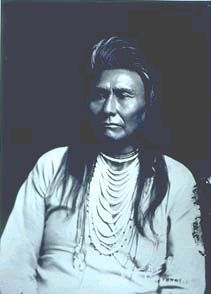|
Information provide by Stan Haggart
Anthropologists and historians are not
altogether clear about when the horse was acquired by the Nez
Perce. It is generally believed and accepted that horses were
introduced to the Americas by the Spanish about 1730 and that the
Plains Indians soon acquired them. However, the Appaloosa, or
spotted horse, has been found in pictographs of Asian and Chinese
art. Prominent anthropologists have theorized that the Nez Perce
and other Pacific Northwest tribes may have migrated across a land
bridge that may have existed between the Asian and North American
Continents somewhere near the Bering Straits off the coast of
Alaska shortly after the last glaciers on the North American
Continent began to recede. If this is true, then, perhaps the Nez
Perce and the Appaloosa horse were interlinked much longer than
thought.
Whatever
the case may be, we know from reports of Captains Lewis and Clark
that the Nez Perce were fond of Appaloosas and raised beautiful
horses. Lewis noted that on their return trip from the Pacific in
1806, while staying with the Nez Perce, that the Nez Perce had the
largest horse herd on the Continent. The horse was an important
form of transportation to the Nez Perce people. It enabled them to
travel great distances to visit other tribes, to participate in
the Trapper Rendezvous, and to travel to the Buffalo country of
present-day Montana and Wyoming.
In 1835 Chief
Lawyer met Reverend Marcus Whitman and Reverend Samuel Parker at
the Green River Rendezvous. Later, Chief Lawyer would play an
important role in helping the missionaries pursue their work among
the Nez Perce. He often traveled between the Whitman Mission
located near present-day Walla Walla and his ancestral lands near
Kamiah where he lived. It was during one of these long journeys
that he helped resolve the intense personality conflict that
existed between Reverend Marcus Whitman and Reverend Asa Smith. He
encouraged Asa to travel to Kamiah and set up a mission there and
work on a Nez Perce language dictionary which Asa did. Chief
Looking Glass, a famous warrior and hunter, traveled to Montana
numerous times to hunt buffalo. We know, for example, that in 1873
Chief Looking Glass was in present-day Montana where he helped the
Crow defeat the Sioux at the Battle of Pryor Creek.
Source of Wealth and Income
The Appaloosa horse was not only a source of
pride and transportation for the Nez Perce people, it was also a
source of wealth. During the 1800s, the Nez Perce were considered
to be wealthy people by any standard you would care to measure
wealth. Chief Joseph's own experiences and comments provide us
with important glimpses into the significance of the Appaloosa as
a source of wealth.
Chief
Joseph 1900's. The
above photo have been made available by the National
Anthropological Archives, Smithsonian Institution.
 |
In 1870 ranchers rode up to the Wallowa Plateau in search of grass
for their cattle, since cattle in the Grand Ronde area had been
suffering from severe drought. One of the ranchers remarked to his
companions as he stood gazing at a meadow on the slopes of Joseph
Canyon that "there must be 10,000 head of horses in that
meadow." In July of 1872 Joseph began a diplomatic initiative
working for the removal of settlers from Joseph's ancestral lands
in the Wallowas. A series of diplomatic meetings resulted in
Joseph's stature and influence being raised. He was considered by
his adversaries to be eloquent, logical and to possess a keen
intellect. One particular intense meeting between Superintendent
of Indian Affairs for Oregon Territory, T. B. Odeneal, and Nez
Perce Reservation Indian Agent, John Monteith, on March 27, 1873,
was very important. Joseph's response provides us with insight
into his views of Nez Perce wealth and the importance of the
Appaloosa horse to the economic well being of his people.
" I will not (move to reservation). I do not need your help;
we have plenty, and we are contented and happy if the white man
will let us alone. The reservation is too small for so many people
with all their stock. You can keep your presents; we can go to
your towns and pay for all we need; we have plenty of horses and
cattle to sell, and we won't have any help from you; we are free
now; we can go where we please, our fathers were borh here. Here
they lived, here they died, here are their graves. We will never
leave them."
Source: Howard, Helen Addison, Saga of Chief Joseph,p.92-93.
quoted from the Report of The Secretary of Interior, 1872-73.
|



